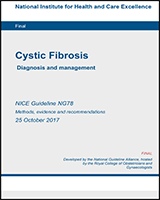From: 9, Pulmonary monitoring, assessment and management

NCBI Bookshelf. A service of the National Library of Medicine, National Institutes of Health.
| Comparison 14. Non-invasive ventilation (NIV) compared to no airway clearance technique for CF | ||||||
|---|---|---|---|---|---|---|
| Outcomes | Illustrative comparative risks* (95% CI) | Relative effect (95% CI) | No of Participants (studies) | Quality of the evidence (GRADE) | Comments | |
| Assumed risk | Corresponding risk | |||||
| No airway clearance technique | Non-invasive ventilation (NIV) | |||||
| Lung function - FEV1 % predicted Scale from: 0 to 100 Follow-up: 6 weeks | The mean FEV1 % predicted in the control groups was 32 | The mean FEV1 % predicted in the NIV groups was 1 higher (8.62 lower to 10.62 higher) | 8 (Young 2008) | ⊕⊕⊝⊝ low1 | ||
| Lung function - FVC % predicted Scale from: 0 to 100 Follow-up: 6 weeks | The mean FVC % predicted in the control groups was 54 | The FVC% predicted in the NIV groups was 4 higher (10.3 lower to 18.3 higher) | 8 (Young 2008) | ⊕⊕⊝⊝ low2 | ||
| Oxygen saturation (nocturnal) % Scale from: 0 to 100 Follow-up: 6 weeks | The mean oxygen saturation (%) (nocturnal) in the control groups was 89 | The mean oxygen saturation (nocturnal) (%) in the NIV groups was 3 higher (1.12 lower to 7.12 higher) | 8 (Young 2008) | ⊕⊕⊕⊝ moderate3 | ||
| Quality of life - CF QOL chest symptom score Scale from: 0 to 100 Follow-up: 6 weeks | The mean CFQOL chest symptom score in the control groups was 64 | The mean CF-QOL chest symptom score in the NIV groups was 7 higher (11.73 lower to 25.73 higher) | 8 (Young 2008) | ⊕⊕⊝⊝ low1,4 | ||
| Quality of life - CF QOL traditional dyspnoea index score Scale from: 0 to 100 Follow-up: 6 weeks | The mean CFQOL traditional dyspnoea index score in the control groups was −1.9 | The mean CF-QOL traditional dyspnoea index score in the NIV groups was 2.9 higher (0.71 to 5.09 higher) | 8 (Young 2008) | ⊕⊕⊕⊝ moderate4,5 | ||
The basis for the assumed risk (e.g. the median control group risk across studies) is provided in footnotes. The corresponding risk (and its 95% confidence interval) is based on the assumed risk in the comparison group and the relative effect of the intervention (and its 95% CI).
Abbreviations: CI: confidence interval; FEV1: forced expiratory volume in 1 second; FVC: forced vital capacity; MD: mean difference; NIV: non-invasive ventilation
The quality of the evidence was downgraded by 2 due to very serious imprecision as 95% CI crossed 2 clinical MIDs
The quality of the evidence was downgraded by 2 due to very serious imprecision as 95% CI crossed 2 default MIDs
The quality of the evidence was downgraded by 1 due to serious imprecision as 95% CI crossed 1 default MID
Clinical MID=5 was used to assess imprecision for quality of life because the CF QOL questionnaire (Gee et al. 2000) was used
The quality of the evidence was downgraded by 1 due to serious imprecision as 95% CI crossed 1 clinical MID
From: 9, Pulmonary monitoring, assessment and management

NCBI Bookshelf. A service of the National Library of Medicine, National Institutes of Health.